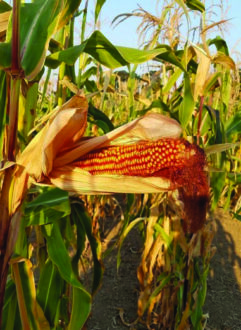As farmers and agricultural researchers work to adapt to changing climatic conditions, some are looking to future innovations, some are exploring past agricultural practices, and some are doing both.
In Western Oregon, a collaborative effort to establish and expand dry farming – growing crops without irrigation – is decidedly in the “doing both” camp.
“There is enough winter rain in Western Oregon to dry farm summer crops like corn, tomatoes and melons,” explained Lucas Nebert, a research associate in the Department of Horticulture at Oregon State University. “The problem is that many commercial varieties of seeds for these crops haven’t been dry-farm adapted.”
So with a Western SARE Professional + Producer grant, Nebert started a corn breeding project to improve the ability of open-pollinated corn varieties to grow successfully during drought and in dry-farmed conditions. In the arid West, where summer rains are scarce, the vast majority of corn acreage is irrigated.
“Plants all around us survive the summer without irrigation, so why can’t we have certain crops do the same?” he said. “What we’re doing with the corn breeding project is nudging the varieties so they’ll perform better in dry-farmed conditions.”
A group of 11 mostly organic growers in the Willamette Valley planted the different corn varieties at multiple sites. Some had dry farmed before while others were trying it for the first time. Some tilled their fields while others used no-till practices. Their results were both interesting and encouraging.
First, soil composition is critical for successful dry farming, Nebert said. Sandy soils don’t hold as much water, so are less suitable for dry farming.
The second most important factor in the successful trials was the variety of corn planted, with the more drought-tolerant varieties out-performing standard varieties.
“In parts of the country, markets for dry farmed produce already exist,” he said. “In Coastal California, dry farmed tomatoes and dry farmed melon are sought-out, valued commodities. In the Willamette Valley, there is more drought stress so those same varieties don’t do as well here. We have to develop varieties that can be dependable, can be successful in our dry farmed conditions.”
Other early lessons from the corn trials: No-till and shallow tillage were also more successful than deep tilling, because tillage allows moisture to escape the soil.
Dry farmed yields weren’t as high as fields that were irrigated, but as Nebert explained, “dry farming isn’t a yield-maximizing strategy.” Instead, it’s an options-maximizing strategy for a grower who doesn’t have an allotment of irrigation water one season or has their allotment cut during drought conditions.
“Also, there are a lot of costs associated with irrigating,” Nebert said. “Equipment, moving pipes, weeding. We found that it took half the time to weed dry-farmed fields and that’s significant because organic farming has weed problems. With lower weed pressure, dry farming doesn’t require as much labor.”
Beyond developing dry-farm-adapted seeds, Nebert and others involved with the Oregon State University Dry Farming Project are mapping the state of Oregon to find areas where dry farming can work. Based on soil and precipitation maps, a dry farming overlay will show where producers could turn to this cropping system.
Nebert also received a Western SARE Research to Grass Roots grant for a dry farming acceleration project, helping growers try dry farming for the first time.
